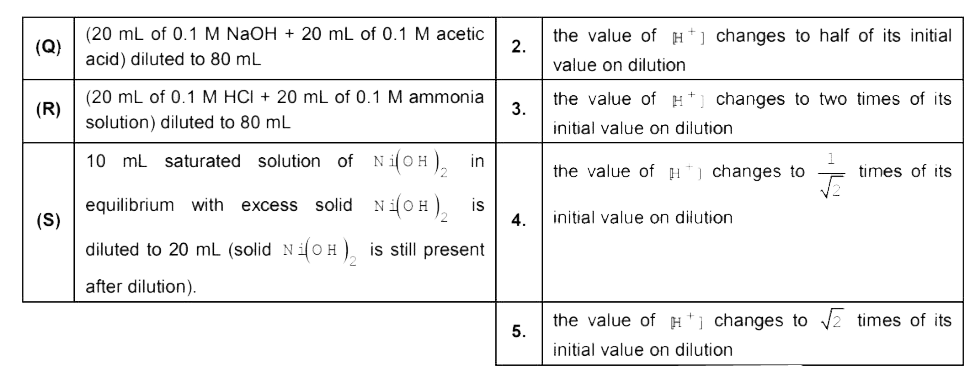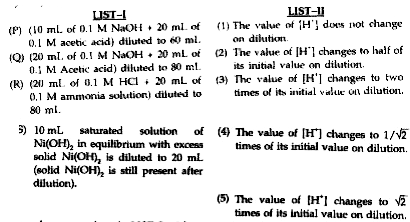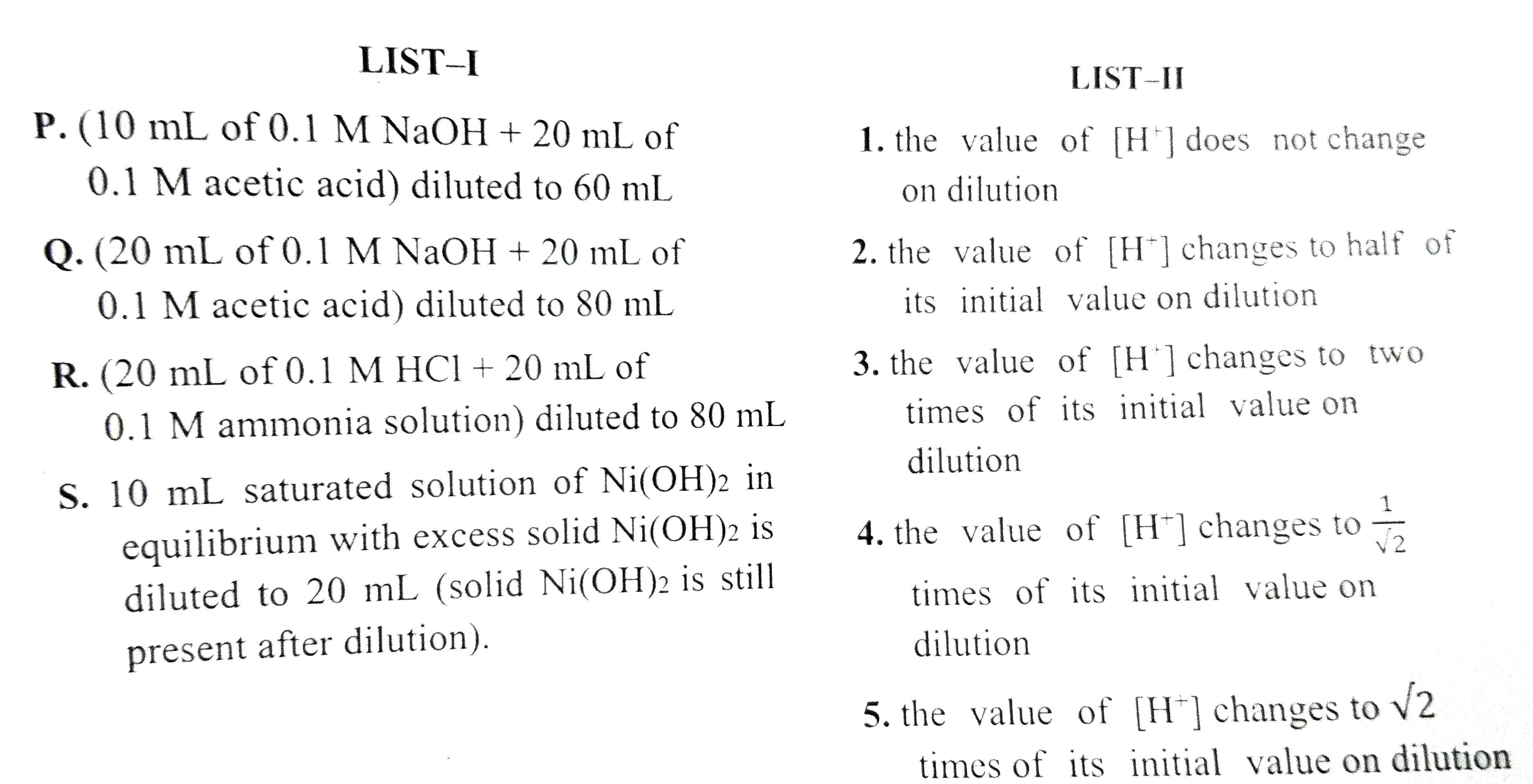Dilution process of different aqueous solutions with water are given in List-I. The effects of dilution of the solutions on [H+] are given in List-II.
(Note : Degree of dissociation (α) of weak acid and weak base is << 1 , degree of hydrolysis of salt <<1,[H+] represents the concentration of H+ ions )
![Dilution process of different aqueous solutions with water are given in List-I. The effects of dilution of the solutions on [H^(+)] are given in List-II. (Note : Degree of dissociation (alpha) of weak acid and weak base is lt lt 1 , degree of hydrolysis of salt lt lt 1 , [H^(+)] represents the concentration of H^(+) ions )](https://d10lpgp6xz60nq.cloudfront.net/physics_images/PR_CHE_01_XI_C07B_E24_003_Q01.png)
P→4,Q→2,R→3,S→1
P→4,Q→3,R→2,S→3
P→1,Q→4,R→5,S→3
P→1,Q→5,R→4,S→1
The correct Answer is:D
(P)NaOH+CH3COOH−−→CH3COONa+H2O10mL20mlof0.1Mof 0.1M=1m mol= 2 m mol a
CH3COOH left = 1 m mol ,
CH3COONa formed = 1 m mol
Thus, it is an acidic buffer solution. [H+] does not change with dilution
Hence, p→1
(Q)NaOH+CH3COOH−−→CH3COONa+H2O20mL20mlof0.1Mof 0.1M=2m mol= 2 m mol a
Thus, they will react completely to from 2 m mol of CH3COONa in 40 mL solution, diluted to 80 m L , i.e., new concentration is halved . As CH3COONa is a salt of weak acid strong base,
[H+]=√Kw×KaC∴[H+]old=√Kw×KaC,
[H+]new=√Kw×KaC/2=[H+]old×√2
Hence , Q→5
(R)HCl+NH3−−→NH4Cl20mL20mlof0.1Mof 0.1M=1m mol= 2 m mol a
Thus, they react completely to form 2 m mo of NH4Cl in 40 mL solution, diluted to 80 mL , i.e., new concentration is halved . As NH4Cl is a salt of strong acid weak base.
[H+]=√KwCKb∴[H+]old=√KwCKb,
[H+]new=√Kw(C/2)Kb=[H+]old×1√2
Hence, R→4
(S) Ni(OH)2(s)⇔Ni2+(aq)+2OH−(aq)
It is a sparingly soluble salt. In saturated solution, [OH−] will remain constant and therefore, [H+] will remain constant, i.e., [H+] does not change on dilution.
Hence , S→1.
Topper's Solved these Questions
- EQUILIBRIUMBOOK - PRADEEPCHAPTER - EQUILIBRIUMEXERCISE - Competition Focus (V. Matrix-Match Type Questions)
2 Videos
- EQUILIBRIUMBOOK - PRADEEPCHAPTER - EQUILIBRIUMEXERCISE - Competition Focus (VI. Integer Type Questions)
12 Videos
- EQUILIBRIUMBOOK - PRADEEPCHAPTER - EQUILIBRIUMEXERCISE - Competition Focus (III. Multiple Choice Questions( Based on the given Passage/Comprehension))
7 Videos
- ENVIRONMENTAL CHEMISTRYBOOK - PRADEEPCHAPTER - ENVIRONMENTAL CHEMISTRYEXERCISE - COMPETITION FOCUS (JEE(Main and Advanced)/Medical Entrance (VI.ASSERTION-REASON) Type II
6 Videos
- EQUILIBRIUM IN PHYSICAL AND CHEMICAL PROCESSESBOOK - PRADEEPCHAPTER - EQUILIBRIUM IN PHYSICAL AND CHEMICAL PROCESSESEXERCISE - Competition Focus (Jee(Main and advanced)/Medical Entrance) VIII. ASSERTION - REASON TYPE QUESTIONS (TYPE - II)
10 Videos
Similar Questions
Dilution process of different aqueous solution , with water are given in List-I. The effects of dilution of the solutions on [H+] are given in List-II. (Note : Degree of dissociation (α) of weak acid and weak base is ltlt 1, degree of hydrolysis of salt <<1,[H+] represents the concentration of H+ ions)
∣∣ ∣ ∣ ∣ ∣ ∣ ∣ ∣ ∣ ∣ ∣ ∣ ∣ ∣ ∣ ∣ ∣∣ List-I List -II(P)(10 mL of 0.1 M NaOH+20 mL of 0.1 acetic acid)dilutes to 60 mL(1)The value of [H+] does not change on dilution(Q)(20 mL of 0.1 M NaOH + 20 mL of 0.1 M acetic acid)diluted to 80 mL(2)The value of [H+] change to half of its initial value on dilution(R)(20 mL of 0.1 M HCl + 20 mL of 0.1 M ammonia solution)diluted to 80 mL(3)The value of [H+] change to two times of its initial value on dilution(S)10 mL saturated solution of Ni(OH)2 in equilibrium with excess solid Ni(OH)2 is (4)The value of [H+] changes to 1√2 times of its initial value on dilutiondiluted to 20 mL (solid Ni(OH)2 is still present after dilution)(5)The value of [H+] changes to √2 times of its initial value on dilution∣∣ ∣ ∣ ∣ ∣ ∣ ∣ ∣ ∣ ∣ ∣ ∣ ∣ ∣ ∣ ∣ ∣∣
View SolutionDilution processes of different aqueous solutions, with water, are given in LIST-I. The effects of dilution of the solutions on [H+]. are given in LIST-II.(Note: Degree of dissociation (α) of weak acid and weak base is<<1, degree of hydrolysis of salt <<1, [H+] represents the concentration of [H+] ions)
Match each process given in LIST-I with one or more effect(s) in LIST-II. The correct option is

View Solution
Knowledge Check
Dilution processes of different aqueous solutions with water are given in LIST-I. The effect of dilution of the solution on [H+] are given in List =II.
 AP-4, Q-2, R-3, S-1BP-4, Q-3, R-2, S-3CR-1, Q-4, R-5L S-3DP-1, Q-5, R-4, S-1
AP-4, Q-2, R-3, S-1BP-4, Q-3, R-2, S-3CR-1, Q-4, R-5L S-3DP-1, Q-5, R-4, S-1The degree of hydrolysis of a salt of weak acid and weak base in its 0.1 M solution is 0.2 M, the precentage hydrolysis of the salt should be
A50%B35%C75%D100%Degree hydrolysis (h) of a salt of weak acid and a strong base is given by
Ah=√KhcBh=√KhCh=√cKhDh=√KwKb
Dilution processes of different aqueous solutions, with water, are given in LIST-I. The effects of dilution of the solutions on [H+] are given in LIST-II. (Note: Degree of dissociation (α) of weak acid and weak base is << 1, degree of hydrolysis of salt <<1,[H+] represents the concentration of H+ ions)

View SolutionDegree hydrolysis (h) of a salt of weak acid and a strong base is given by
View SolutionThe pH of a 0.1 M aqueous solution of a weak acid (HA) is 3. What is its degree of dissociation ?
View SolutionThe pH of a 0.1 M aqueous solution of a weak acid (HA) is 3. What is its degree of dissociation ?
View SolutionHA is a weak acid. The pH of 0.1 M HA solution is 2. What is the degree of dissociation (α) of HA ?
View Solution
